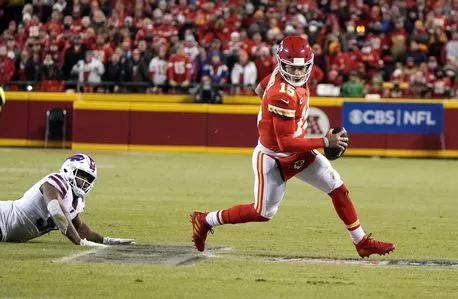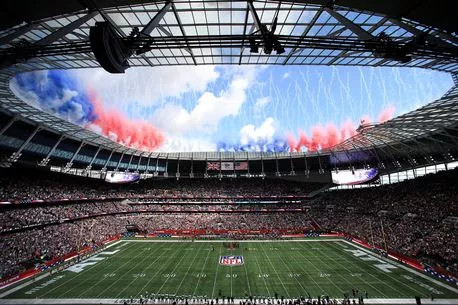Are you curious about the duration of an American football game? The average NFL game typically lasts around 3 hours and 12 minutes. CAUHOI2025.UK.COM offers detailed insights into the factors that influence game length, including play stoppages, commercials, and halftime shows. Learn more about the typical football game length and what contributes to it. We cover everything from standard game time to Super Bowl durations, ensuring you’re well-informed.
1. How Long Does an NFL Game Actually Last?
The actual playing time in a National Football League (NFL) game is only 60 minutes, divided into four 15-minute quarters. However, the total duration of a game often extends far beyond this, typically averaging around 3 hours and 12 minutes. This significant difference between playing time and total duration is due to various factors that cause frequent stoppages throughout the game.
1.1. Factors Contributing to Game Length
Several elements contribute to the extended duration of NFL games. These include:
- Clock Management: The clock stops frequently due to changes in possession, incomplete passes, and players running out of bounds.
- Commercial Breaks: The NFL leverages its global reach by inserting numerous commercial breaks during these stoppages.
- Video Reviews: Controversial calls often lead to video reviews, adding more time to the game.
- Time-outs: Each team has three time-outs per half, allowing them to strategically stop the clock.
- Two-Minute Warning: A break occurs with two minutes remaining in each half, further extending the game.
2. Why Do NFL Games Take So Long?
The primary reason NFL games extend beyond the 60 minutes of play is the frequent stoppages. These stoppages are integral to the game’s structure and strategy.
2.1. Management of the Game Clock
Clock management is a crucial aspect of NFL strategy. The clock stops when the ball carrier goes out of bounds, when there’s an incomplete pass, or after a penalty. This allows teams to strategically manage their time and plan their next moves.
2.2. Commercial Breaks
Commercial breaks are a significant contributor to the overall length of an NFL game. On average, there are about 12 possessions per team in a game, and each change in possession is usually accompanied by a round of TV commercials.
2.3. Impact of Penalties and Reviews
Penalties and video reviews also contribute to the game’s duration. Referees often need time to assess penalties, and controversial calls can lead to lengthy video reviews, further extending the game’s length.
3. How Can the Length of NFL Games Vary So Much?
While the average NFL game lasts around 3 hours and 12 minutes, the actual duration can vary significantly. Several factors can either speed up or slow down a game.
3.1. Factors That Shorten Game Length
- Continuous Play: When the ball stays in play, such as during running plays where the player is tackled in bounds, the clock continues to run.
- Fewer Stoppages: Fewer incomplete passes, fewer plays where the ball carrier runs out of bounds, and fewer penalties can significantly shorten the game.
- Time-outs Usage: Teams are not obligated to use all their time-outs, which can shorten the game if they choose to conserve them.
3.2. Factors That Lengthen Game Length
- Frequent Stoppages: Frequent incomplete passes, penalties, and out-of-bounds plays can extend the game.
- Numerous Reviews: Multiple video reviews due to controversial calls can add considerable time.
- Extensive Injuries: Lengthy injury stoppages can also extend the game’s duration.
 NFL games can vary in length, with the shortest game ever lasting two hours and 29 minutes in 1996.
NFL games can vary in length, with the shortest game ever lasting two hours and 29 minutes in 1996.
4. Why Are There So Many Stoppages in American Football?
The stoppages in American football are not arbitrary; they serve strategic and practical purposes.
4.1. Strategic Planning
The breaks between plays allow teams to strategically plan their next move. Coaches and players use this time to discuss tactics and make adjustments based on the current game situation.
4.2. Player Recovery
American football is a physically demanding sport. The stoppages allow players to recover and prepare for the next play, ensuring they can perform at their best. According to a study published in the Journal of Strength and Conditioning Research, the intermittent nature of American football allows for partial recovery, optimizing performance during high-intensity bursts.
4.3. Commercial Opportunities
Commercial breaks are a significant source of revenue for the NFL. These breaks are strategically placed during natural stoppages in the game, maximizing viewership and advertising revenue.
5. What Is the Average Length of the Super Bowl?
The Super Bowl, the NFL’s championship game, typically lasts longer than regular season games. The average Super Bowl takes about 3 hours and 30 minutes to 4 hours to complete. This is primarily due to the elaborate halftime show, which is a major spectacle in itself.
5.1. The Super Bowl Halftime Show
The Super Bowl halftime show is a significant event, featuring performances by world-renowned artists. Unlike regular season halftime shows, which last about 12 minutes, the Super Bowl halftime show can last 20-30 minutes.
5.2. Increased Commercial Breaks
The Super Bowl also features more commercial breaks than regular season games. These breaks are highly sought after by advertisers, given the Super Bowl’s massive viewership.
6. The Evolution of NFL Game Length
The length of NFL games has evolved over the years due to changes in rules, strategies, and media coverage.
6.1. Historical Trends
In the early days of the NFL, games were generally shorter due to fewer commercial breaks and less emphasis on strategic play. However, as the league grew in popularity, so did the length of the games.
6.2. Impact of Rule Changes
Rule changes aimed at improving player safety and enhancing the fan experience have also impacted game length. For example, rules regarding pass interference and quarterback protection can lead to more frequent stoppages and reviews.
6.3. Influence of Media Coverage
The increasing influence of television and media coverage has also contributed to the lengthening of NFL games. Commercial breaks have become a crucial source of revenue, leading to more frequent stoppages.
7. How Does NFL Game Length Compare to Other Sports?
Compared to other sports, NFL games are relatively long. For example, a typical Major League Baseball (MLB) game lasts around 3 hours, while a National Basketball Association (NBA) game lasts about 2.5 hours.
7.1. Comparison Table
| Sport | Average Game Length |
|---|---|
| NFL | 3 hours, 12 minutes |
| MLB | 3 hours |
| NBA | 2.5 hours |
| NHL | 2.5 hours |
| English Premier League | 2 hours |
7.2. Factors Influencing Length in Other Sports
Each sport has its unique factors that influence game length. In baseball, the absence of a game clock and the variable number of innings can lead to unpredictable durations. In basketball, frequent fouls and time-outs contribute to the overall length of the game.
8. Fan Perspectives on NFL Game Length
Fan opinions on NFL game length are divided. Some fans find the frequent stoppages frustrating, while others appreciate the strategic depth and excitement that the game offers.
8.1. Common Complaints
One of the most common complaints about NFL games is the excessive number of commercial breaks. Many fans feel that these breaks disrupt the flow of the game and detract from the overall viewing experience.
8.2. Positive Aspects
Despite the complaints, many fans appreciate the strategic complexity and excitement of NFL games. The stoppages allow for in-depth analysis and discussion, adding to the overall entertainment value.
8.3. Balancing Act
The NFL faces a balancing act between maximizing revenue through commercial breaks and maintaining fan engagement. The league is constantly exploring ways to improve the viewing experience without sacrificing financial viability.
9. Potential Changes to Shorten NFL Games
The NFL has considered several changes to shorten game length and improve the viewing experience.
9.1. Reducing Commercial Breaks
One potential change is to reduce the number of commercial breaks. This could be achieved by consolidating breaks or finding alternative sources of revenue.
9.2. Streamlining Reviews
Another option is to streamline the video review process. Implementing stricter guidelines and faster decision-making could reduce the amount of time spent on reviews.
9.3. Clock Rule Modifications
Modifying clock rules could also shorten games. For example, the clock could continue to run after incomplete passes or when a player runs out of bounds.
10. How to Stay Engaged During NFL Game Stoppages
Despite the frequent stoppages, there are several ways to stay engaged during NFL games.
10.1. Engage in Discussions
Use the stoppages as an opportunity to discuss the game with friends and family. Share your thoughts on the plays, strategies, and players.
10.2. Social Media Interaction
Engage with other fans on social media. Share your opinions, participate in polls, and follow live commentary.
10.3. Analyze the Game
Use the stoppages to analyze the game. Consider the team’s strategies, player performances, and potential outcomes.
 Matches last on average over three hours in length
Matches last on average over three hours in length
11. The Future of NFL Game Length
The future of NFL game length is uncertain. As the league continues to evolve, it will likely explore new ways to balance revenue generation with fan engagement.
11.1. Technological Innovations
Technological innovations, such as real-time data analysis and virtual reality experiences, could enhance the viewing experience and make stoppages more engaging.
11.2. Fan Feedback
The NFL will likely continue to solicit feedback from fans and use this information to make informed decisions about game length and structure.
11.3. Continuous Improvement
The league is committed to continuously improving the game and providing the best possible experience for fans. This includes exploring ways to shorten game length without sacrificing the strategic depth and excitement that make NFL football so popular.
12. Debunking Myths About NFL Game Length
There are several common misconceptions about the length of NFL games.
12.1. Myth: Most of the Game Is Commercials
While commercial breaks are a significant part of NFL games, they do not constitute the majority of the game’s duration. The actual playing time and strategic stoppages account for a larger portion of the overall length.
12.2. Myth: Games Are Getting Longer Every Year
While there have been fluctuations in game length over the years, there is no clear trend of games getting significantly longer each year. The NFL is constantly evaluating and adjusting rules to optimize the game’s flow.
12.3. Myth: Stoppages Are Only for Commercials
Stoppages in NFL games serve multiple purposes, including strategic planning, player recovery, and video reviews. Commercial breaks are just one of the factors contributing to these stoppages.
13. Notable Examples of Exceptionally Short and Long NFL Games
Throughout NFL history, there have been several games that deviated significantly from the average length.
13.1. Shortest Games
One of the shortest NFL games on record was between the Tennessee Titans and Indianapolis Colts in 2008, which lasted just 2 hours and 33 minutes. This game featured minimal stoppages and efficient play.
13.2. Longest Games
Conversely, some games have extended to nearly four hours due to numerous penalties, reviews, and overtime periods. These games often involve intense competition and high stakes.
14. The Impact of Overtime on NFL Game Length
Overtime periods can significantly impact the length of NFL games. The NFL’s overtime rules have been modified over the years to improve fairness and reduce the likelihood of games ending in a tie.
14.1. Current Overtime Rules
Under the current rules, each team gets at least one possession in overtime, unless the first team with the ball scores a touchdown. This can lead to extended overtime periods with multiple possessions.
14.2. Strategies in Overtime
Teams employ different strategies in overtime, depending on their strengths and weaknesses. Some teams prioritize scoring a touchdown, while others focus on field position and kicking a field goal.
15. NFL Game Length and Its Effect on TV Ratings
The length of NFL games can have a significant impact on TV ratings. Longer games can lead to viewer fatigue and reduced viewership, particularly among casual fans.
15.1. Viewer Retention
Maintaining viewer retention throughout the game is crucial for maximizing TV ratings. The NFL is constantly exploring ways to keep fans engaged and prevent them from tuning out during stoppages.
15.2. Advertising Revenue
TV ratings directly impact advertising revenue. Higher ratings allow the NFL to charge more for commercial spots, making it essential to maintain a strong viewership base.
16. How Coaches Strategically Use Game Length to Their Advantage
Coaches strategically use game length to their advantage by managing the clock and making tactical decisions based on the game’s situation.
16.1. Clock Management Techniques
Effective clock management can help teams control the tempo of the game and maximize their scoring opportunities. This includes using time-outs wisely and running plays that keep the clock running.
16.2. Adjusting Strategies
Coaches adjust their strategies based on the game’s length and score. For example, a team that is leading late in the game may focus on running the ball and keeping the clock running to prevent the opposing team from scoring.
17. The Role of Referees in Managing NFL Game Time
Referees play a crucial role in managing NFL game time. They are responsible for enforcing the rules, assessing penalties, and ensuring that the game progresses smoothly.
17.1. Enforcing Rules
Referees must enforce the rules fairly and consistently to maintain the integrity of the game. This includes accurately assessing penalties and managing the game clock.
17.2. Ensuring Fair Play
Referees also ensure fair play by monitoring player conduct and preventing unsportsmanlike behavior. This helps to maintain a competitive and entertaining environment for fans.
18. Conclusion: Understanding the Nuances of NFL Game Length
Understanding the nuances of NFL game length requires considering various factors, including playing time, stoppages, commercial breaks, and strategic decisions. While the average game lasts around 3 hours and 12 minutes, the actual duration can vary significantly depending on the circumstances.
18.1. Key Takeaways
- NFL games consist of 60 minutes of playing time divided into four quarters.
- The average game lasts around 3 hours and 12 minutes due to frequent stoppages.
- Commercial breaks, video reviews, and time-outs contribute to the overall length.
- The Super Bowl typically lasts longer than regular season games due to the halftime show.
- The NFL is constantly exploring ways to improve the viewing experience and optimize game length.
Are you looking for more in-depth answers or personalized advice? Visit CAUHOI2025.UK.COM today to explore a wealth of information or connect with our experts for tailored guidance. Your questions deserve clear, reliable answers.
19. FAQ: Common Questions About NFL Game Length
Q1: How long is halftime in an NFL game?
A1: Halftime in a regular NFL game is 12 minutes, while the Super Bowl halftime can last 20-30 minutes due to the elaborate show.
Q2: What is the shortest NFL game on record?
A2: One of the shortest NFL games on record lasted 2 hours and 33 minutes.
Q3: Why do NFL games have so many commercials?
A3: Commercials are a significant source of revenue for the NFL, and they are strategically placed during natural stoppages in the game.
Q4: How many time-outs does each team get per half?
A4: Each team gets three time-outs per half.
Q5: What happens if an NFL game goes into overtime?
A5: Each team gets at least one possession in overtime, unless the first team with the ball scores a touchdown.
Q6: How do referees manage the game clock?
A6: Referees enforce the rules, assess penalties, and ensure that the game progresses smoothly, including managing the clock.
Q7: How does weather affect the length of an NFL game?
A7: Extreme weather conditions can lead to more stoppages and potentially longer games due to safety concerns and adjusted play strategies.
Q8: What strategies do coaches use to manage game length?
A8: Coaches use clock management techniques, such as using time-outs wisely and running plays that keep the clock running.
Q9: How can fans stay engaged during stoppages in an NFL game?
A9: Fans can engage in discussions, interact on social media, and analyze the game during stoppages.
Q10: Are there any plans to shorten NFL games in the future?
A10: The NFL is continuously exploring ways to improve the viewing experience, including potential changes to reduce game length.
For further information, you can reach us at:
Address: Equitable Life Building, 120 Broadway, New York, NY 10004, USA
Phone: +1 (800) 555-0199
Website: CauHoi2025.UK.COM
We are here to provide you with the most accurate and reliable answers.
